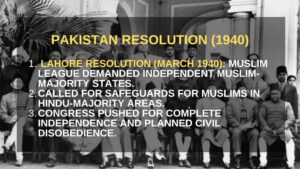World War 2 began in September 1939 when Germany invaded Poland. Before this, Germany had already taken control of Austria in 1938 and Czechoslovakia in 1939. Initially, Britain and France tried to appease Hitler, but after the invasion of Poland, they declared war on Germany.
The Two Sides of the World War 2
The war was fought between two major groups:
- Allied Powers – Britain, France, Russia, and the United States of America.
- Axis Powers – Germany, Italy, and Japan.
Download notes of Non Cooperation Movement & Khilafat Movement
India’s Involvement in the War
The British Indian government declared India’s support for the war without consulting Indian leaders or Congress. This led to various political reactions in India.
Congress’s Response and the Wardha CWC Meeting (September 1939)
Congress was unhappy that India was dragged into the war without being consulted. However, it was sympathetic to the victims of fascism. The party agreed to support the anti-fascist alliance only if Britain promised to grant India self-governance and allow a constituent assembly to draft a free India’s constitution.
Key Leaders’ Views:
- Mahatma Gandhi: Advocated unconditional support to the British in fighting fascism.
- Subhash Chandra Bose & Socialists: Opposed both sides, seeing them as imperialist forces. They urged Congress to use the situation to launch a civil disobedience movement.
- Jawaharlal Nehru: Believed that while Britain and France represented democracy against fascism, they were still imperialist nations. He argued that India should not support the war without first gaining independence.
The Congress Working Committee (CWC) Resolution
After debates, Congress adopted Nehru’s position. The resolution:
- Condemned Nazism and Fascism.
- Refused to support a war for democracy while India itself was not free.
- Demanded that Britain clarify its war aims and how they would apply to India.
British Response and Resignation of Congress Ministries
The British government did not accept Congress’s demands. Instead, it tried to create divisions in India by supporting the Muslim League and princely states. The British also passed the Defence of India Rules to suppress anti-government activities.
Gandhi’s Reaction: He strongly opposed the British stance and condemned their refusal to grant India freedom.
As a protest, Congress ministries across provinces resigned. However, Congress leaders were still reluctant to launch an immediate mass struggle.
Debates on Mass Struggle
A debate emerged within Congress on whether to launch a mass movement against British rule.
- Gandhi: Opposed immediate struggle as he believed the people were not ready.
- Other Leaders: Wanted a movement but could not agree on its form.
- Outcome: The decision on mass struggle was left to Gandhi.
The Pakistan Resolution (1940)
In March 1940, the Muslim League passed the Lahore Resolution, demanding:
- Independent states for Muslim-majority areas.
- Safeguards for Muslims in Hindu-majority regions.

Image source: Wikipedia
At this point, Congress decided to push for complete independence and to launch a civil disobedience movement when conditions were favorable.
The August Offer (1940)
With the fall of France, Belgium, and Holland, the British tried to seek India’s support by offering:
- More Indian representation in the Executive Council.
- Dominion status after the war.
- A future constitution-making body.
- No new constitution without the consent of minorities.
Responses:
- Congress: Rejected the offer, demanding immediate independence.
- Muslim League: Also rejected it as it did not explicitly mention Pakistan.
Individual Satyagraha (1940-41)
After negotiations failed, Gandhi launched Individual Satyagraha, a peaceful protest against British rule.
- First Satyagrahi: Vinoba Bhave.
- Second Satyagrahi: Jawaharlal Nehru.
- Over 25,000 Satyagrahis were arrested by May 1941.
The Cripps Mission (1942)
In March 1942, the British sent Stafford Cripps to negotiate India’s support in the war.
The Proposal:
- India would get Dominion status after the war.
- A constitution-making body would be formed.
- Provinces could opt out of the Indian Union.
- India’s defense would remain under British control during the war.
Responses:
- Congress: Rejected it, demanding complete independence.
- Gandhi: Called it a “post-dated cheque.”
- Muslim League: Opposed it as it did not promise Pakistan.
- Other Groups: Various objections over representation and security.
Significance of Cripps Mission
- It gave India a clear blueprint for partition.
- Strengthened the demand for full independence.
- Marked the first time the British formally recognized India’s right to frame its constitution.
Download notes of Revolutionary Nationalism 2.0
World War 2 significantly impacted India’s independence movement. While Congress refused to support the war without independence, British reluctance to make real concessions led to rising tensions. Eventually, these tensions escalated into the Quit India Movement (1942), which became a crucial step towards India’s freedom.
FAQs related to World War 2nd
Q1: Why did World War 2 start, and how did Britain and France react?
A: It began in September 1939 with Germany’s invasion of Poland. Britain and France, after years of appeasing Hitler, declared war on Germany.
Q2: What was Congress’s initial reaction to India’s involvement in the war?
A: Congress opposed India’s forced involvement and demanded self-governance before offering support.
Q3: Why did Congress reject the August Offer?
A: It did not promise immediate independence and favored Muslim separatists.
Q4: What was the impact of the Cripps Mission’s failure?
A: It led to the Quit India Movement in 1942, demanding an end to British rule in India.


